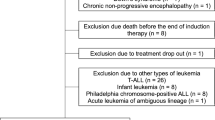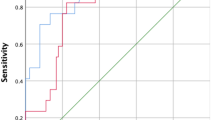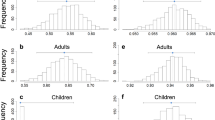Abstract
Children with acute lymphoblastic leukaemia (ALL) typically gain weight at excessive rates during and after therapy, and a high proportion of young adult survivors are obese. Previous studies have failed to identify the abnormalities in energy balance that predispose these children to obesity. The aim of this study was to determine the cause of excess weight gain in children treated for ALL by testing the hypothesis that energy expenditure is reduced in these patients. Twenty children [9 boys, 11 girls; mean age 10.9 (3.2) y] treated for ALL who had shown excess weight gain, but were not obese [mean body mass index SD score 0.70 (1.04)], were closely and individually matched with 20 healthy control children [9 boys, 11 girls; mean age 10.7 (3.0) y; mean body mass index SD score 0.27 (0.91)]. In each child we measured total energy expenditure by doubly-labeled water method, resting energy expenditure, energy expended on habitual physical activity, and energy intake. Total energy expenditure was significantly higher in control subjects than in patients: mean paired difference 1185 kJ/d (282 kcal/d), 95% confidence interval (CI) 218-2152. This difference was largely due to reduced energy expended on habitual physical activity in the patients. Resting energy expenditure was lower in the patients: mean paired difference 321 kJ/d (76 kcal/d), 95% CI 100-541. Energy intake was also lower in the patients: mean paired difference 1001 kJ/d (238 kcal/d), 95% CI 93-1909. Children treated for ALL are predisposed to excess weight gain, and subsequently obesity, by reduced total energy expenditure secondary to reduced habitual physical activity. Prevention of obesity in ALL should focus on modest increases in habitual physical activity, modest restriction of dietary intake, and monitoring of excess weight gain.
Similar content being viewed by others
Log in or create a free account to read this content
Gain free access to this article, as well as selected content from this journal and more on nature.com
or
Abbreviations
- ALL:
-
acute lymphoblastic leukemia
- BMI:
-
body mass index
- TEE:
-
total energy expenditure
- REE:
-
resting energy expenditure
- SDS:
-
SD score
- FFM:
-
fat-free mass
- CI:
-
confidence interval
REFERENCES
Odame I, Reilly JJ, Gibson BES, Donaldson MDC 1994 Patterns of obesity in boys and girls after treatment for ALL. Arch Dis Child 71: 147–149
Van Dongen-Melman JEWM, Hokken-Koelega ACS, Hahler K, de Groot A, Tromp CG, Egeler RM 1995 Obesity after successful treatment of acute lymphoblastic leukemia in childhood. Pediatr Res 38: 86–90
Reilly JJ, Blacklock CJ, Dale E, Donaldson MDC, Gibson BES 1996 Resting metabolic rate and obesity in childhood ALL. Int J Obes 20: 1130–1132
Didi M, Didcock E, Davies HA, Ogilvy-Stuart AL, Wales JKH, Shalet SM 1995 High incidence of obesity in young adults after treatment of ALL in childhood. J Pediatr 127: 63–67
Schell MJ, Ochs JJ, Schrock EA, Carter M 1992 A method of predicting adult height and obesity in long term survivors of childhood ALL. J Clin Oncol 10: 128–133
Zee P, Chen CH 1986 Prevalence of obesity in children after therapy for ALL. Am J Pediatr Hematol Oncol 8: 294–299
Bond SA, Han AM, Wootton SA, Kohler JA 1992 Energy intake and basal metabolic rate during maintenance chemotherapy. Arch Dis Child 67: 229–232
Sawaya AL, Tucker K, Tsay R, Willett W, Saltzman E, Dallal GE, Roberts SB 1996 Evaluation of four methods for determining energy intake in young and older women. Am J Clin Nutr 63: 491–499
Stallings VA, Vaisman N, Weitzman SS, Hahn E, Pencharz PB 1989 Energy metabolism in children with newly diagnosed acute leukemia. Pediatr Res 26: 154–157
Vaisman N, Stallings VA, Chan H, Weitzman SS, Clarke R, Pencharz PB 1993 Effect of chemotherapy on energy and protein metabolism of children near the end of treatment for ALL. Am J Clin Nutr 57: 679–684
Rosenbaum M, Ravussin E, Mathews DE, Gilker C, Ferraro R, Heymsfield SB, Hirsch J, Leibel RL 1996 A comparison of different means of assessing energy expenditure in humans. Am J Physiol 270: R496–R504
Burnett AK, Eden OB 1997 The treatment of acute leukaemia. Lancet 349: 270–275
Cole TJ, Freeman JV, Preece MA 1995 Body mass index reference curves for the UK, 1990. Arch Dis Child 73: 25–29
Carstairs V, Morris R 1991 Deprivation and Health in Scotland. Aberdeen University Press, Aberdeen, UK, 18–37.
Reilly JJ, Wilson J, McColl J, Carmichael M, Durnin JVGA 1996 Ability of bioelectric impedance to predict fat-free mass in prepubertal children. Pediatr Res 39: 176–179
Tanner JM 1962 Growth at Adolescence, 2nd Ed. Blackwell Scientific Publications, Oxford, UK. 1–94.
Lohman TG 1993 Estimating body composition in children and the elderly. Advances in Body Composition Assessment, Monograph 3. Human Kinetics Publishers, Champaign, IL, 65–79.
Schofield WN 1985 Predicting basal metabolic rate. Hum Nutr Clin Nutr 39C( suppl 1): 5-41
Welle S 1990 Two point vs. multipoint sample collection for the analysis of energy expenditure by use of doubly labelled water. Am J Clin Nutr 52: 1134–1138
Schoeller DA, Ravussin E, Schutz Y, Achenson KJ, Baertschi P, Jequier E 1986 Energy expenditure by doubly labelled water: validation in humans and proposed calculation. Am J Physiol 250: R823–R830
Black AE, Prentice AM, Coward WA 1986 Use of food quotients to predict respiratory quotients for the doubly labelled water method. Hum Nutr Clin Nutr 40C: 381–391
Gibson RS 1990 Food consumption of individuals In: Principles of Nutritional Assessment. Oxford University Press, Oxford, UK, 37–54.
Paul AA, Southgate DAT 1978 The Composition of Foods. HMSO, London, 203–297.
Ravussin E, Bogardus C 1989 Relationship of genetics, and physical fitness to daily energy expenditure and fuel utilisation. Am J Clin Nutr 49( suppl): 968–975
Macallan DC, Noble C, Baldwin C, Jebb SA, Prentice AM, Coward WA, Sawyer MB, McManus TJ, Griffin GE 1995 Energy expenditure and wasting in human immunodeficiency virus infection. N Engl J Med 333: 83–88
Prentice AM, Jebb SA 1995 Obesity in Britain: gluttony or sloth? BMJ 311: 437–439
Gortmaker SL, Must A, Sobol AM, Peterson K, Colditz GA, Dietz WH 1996 Television viewing as a cause of increasing obesity among children in the United States. Arch Pediatr Adolesc Med 150: 356–362
Demark-Wahnfried W, Hars V, Conaway MR, Havlin K, Rimer BK, McElveen G, and Winer EB 1997 Reduced rates of metabolism and decreased physical activity in breast cancer patients treated with adjuvant chemotherapy. Am J Clin Nutr 65: 1495–1501
Goran MI, Figeroa R, McGloin A, Nguyen V, Treuth MS, Nagy TR 1995 Obesity in children: recent advances in energy metabolism and body composition. Obes Res 3: 277–289
Torun B, Davies PSW, Livingstone MBE, Paolisso M, Sackett R, Spurr GB 1996 Energy requirements and dietary energy recommendations for children and adolescents 1-18 years old. Eur J Clin Nutr 50( suppl 1): 37s–81s
Epstein LH 1996 Exercise in the treatment of childhood obesity. Int J Obes 19( suppl 4): 117s–121s
Ventham JC, Reilly JJ, Ralston JM, Donaldson M, Gibson BES 1997 Energy balance in pre-obese children treated for ALL. Proc Nutr Soc 56: 316A
Champagne CM, Delany JP, Harsha DW, Bray GA 1996 Under-reporting of energy intake in biracial children verified by doubly labelled water. J Am Diet Assoc 96: 707–709
Livingstone MBE, Prentice AM, Coward WA, Strain JJ, Black AE, Davies PSW, Stewart CM, McKenna PG, Whitehead RG 1992 Validation of estimates of energy intake by weighted dietary record and diet history in children and adolescents. Am J Clin Nutr 56: 29–35
Acknowledgements
The authors acknowledge the help of the patients and control subjects and their families, and Diane Henderson and Evelyn Smith for their assistance in recruitment. We thank Professor Lawrence Weaver and the anonymous referees for their comments on the manuscript and Tom Aitchison for statistical advice.
Author information
Authors and Affiliations
Additional information
Supported by the Leukemia Research Fund. The indirect calorimeter was purchased with a grant from the Royal Society (J.J.R.).
Rights and permissions
About this article
Cite this article
Reilly, J., Ventham, J., Ralston, J. et al. Reduced Energy Expenditure in Preobese Children Treated for Acute Lymphoblastic Leukemia. Pediatr Res 44, 557–562 (1998). https://doi.org/10.1203/00006450-199810000-00015
Received:
Accepted:
Issue date:
DOI: https://doi.org/10.1203/00006450-199810000-00015
This article is cited by
-
EXERCISE in pediatric autologous stem cell transplant patients: a randomized controlled trial protocol
BMC Cancer (2012)
-
Exercise in adult and pediatric hematological cancer survivors: an intervention review
Leukemia (2010)
-
Acute lymphoblastic leukemia and obesity: increased energy intake or decreased physical activity?
Supportive Care in Cancer (2009)
-
Intrahospital supervised exercise training: a complementary tool in the therapeutic armamentarium against childhood leukemia
Leukemia (2005)



